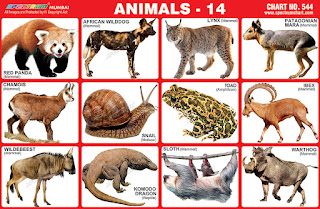Red Panda (Mammal) - Red
panda is also known as "Fire Fox" because of its size and
red colour of the fur. Upper side of the red panda is red and white
in colour. Legs and belly are black. Tail is covered in red and
white rings. Red panda spends most of its life in the trees. Red
panda is an omnivore. It mostly eats bamboo, but it also consumes
fruit, roots, eggs and small mammals.
African Wild Dog (Mammal) -
Wild dog is a member of canine family. These animals inhabit open
plains and woodlands of Sub-Saharan Africa. Wild dogs have long
legs, strong jaws and large, bat-like ears. Their body is covered
with fur which has irregular patches of red, brown, black, yellow
and white colour.
Lynx (Mammal) - Lynx is a
member of the cat family. They have short stubby tails and the long
tufts of black hair on the ear. Lynx are usually solitary animals
and will spend their time both hunting and resting alone. Their
lifespan ranges between 12 - 20 years.
Patagonian Mara (Mammal)
-Patagonian Mara is a relatively large rodent in the mara genus. It
is also known as the Patagonian Cavy. This herbivorous, somewhat
rabbit-like animal is found in open and semi-open habitats in
Argentina only. It has distinctive long ears and long limbs. Its
hind limbs are longer and more muscular than its forelimbs.
Chamois (Mammal) - Chamois
is a type of medium-sized goat-antelope that belongs to the Bovidae
family. Chamois has thick woolly coat that is reddish brown-coloured
during the summer and light grey during the winter. It has white
face with black stripes below eyes, white rump and black stripe on
dorsal side of the body. Chamois has stocky body and short tail.
Chamois is a herbivore. Its diet is based on grass, herbs, flowers,
moss, lichen & leaves.
Snail (Mollusc) - Snail is
a common name for a kind of mollusc. Snails are invertebrates, means
animals with no backbones. The shell on the snail helps protect it
and also reduces the loss of water by evaporation. Shells have many
different shapes, sizes, and colours. Snails do not breathe through
their mouths, instead they have a breathing hole under their shells.
Toad (Amphibian) – Toad
is an amphibians that are characterised by dry, leathery skin, short
legs and parotoid glands. Toad can reach about 15 cm in length.
Toads can live for many years and have survived for fifty years in
captivity.
Ibex (Mammal) – Ibex is a
type of wild goat with a bearded chin for the males and a very short
tail. The males have horns that are very long and that curve at the
top and then back down again. They use these horns for fighting and
to protect themselves. The Ibex can be very curious and adventurous.
They can quickly climb up and down difficult terrain. This helps
them to escape from any types of predators.
Wildebeest (Mammal) -
Wildebeest is a mammal that belongs to the family of antelopes.
Wildebeests live in central, eastern and southern parts of Africa.
They prefer life in green plains and open woodlands. It has large,
box-shaped head, and strongly built front part of the body.
Hindquarters are slender, just like in other antelopes. Wildebeest
is a grazer. It eats mainly short grass. It can live up to 20 years
in wild.
Komondo Dragon (Reptile) -
Komodo dragon is a species of lizard that lives in the Indonesian
islands of Komodo. It is the largest living lizard. They grow to an
average length of 2–3 meters and weigh around 70 kg. They are very
popular animals in zoos because they are very big and look scary.
Sloth (Mammal) - Sloth is a
medium sized animal. It is usually 2 to 2.5 feet long. Sloths have
round face, sad eyes, small ears and short tail. Their body is
covered with wiry fur. Fur of the sloth can be black, brown or grey.
Sloth is herbivore & usually spends 20 hours per day in
sleeping. Sloth is arboreal (lives in the trees) creature.
Warthog (Mammal) - Warthog
is a member of pig family. This animal can be found only in Africa,
in areas located south of Sahara. Warthog lives in arid and moist
savannas, in open plains and grasslands. Warthogs can be grey to
black in colour. Their skin is covered with sparse bristles. Warthogs
have 2 pair of tusks. Upper tusks are longer and they curve toward
each other.


No comments:
Post a Comment